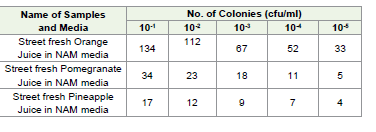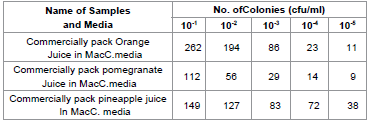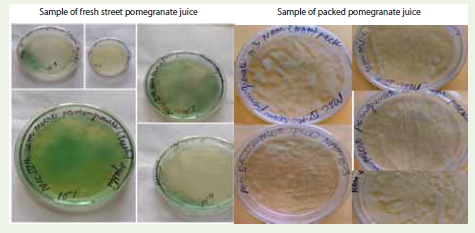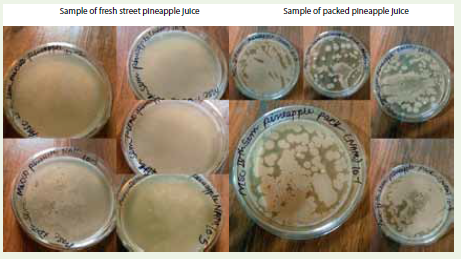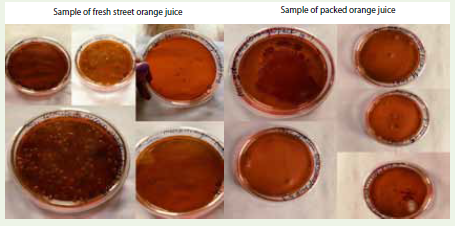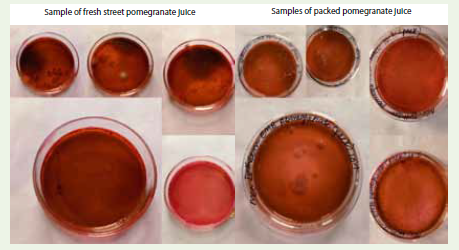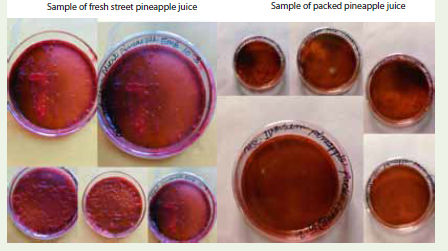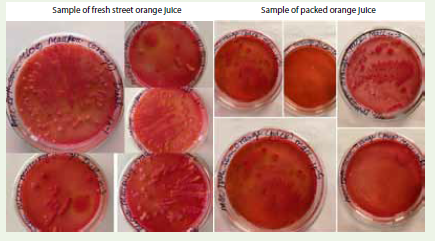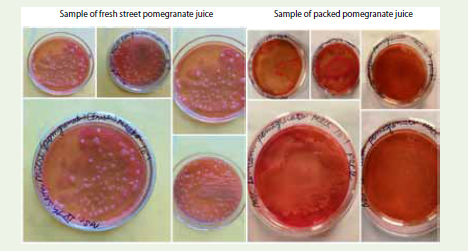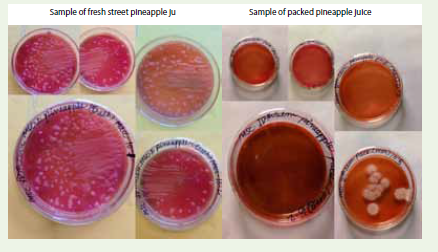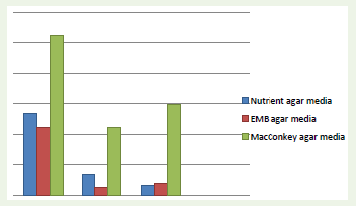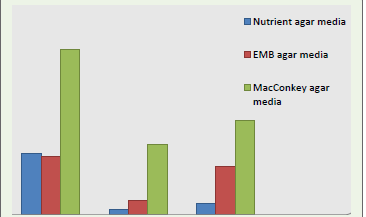Research Article
A Comparative Investigation on the Assessment of Microbial Count Present in Commercially Packed Fruit Juices and Fresh Street Fruit Juices Available in Bilaspur City
Pandey AR* and Ankita B
Department of Microbiology, D.L.S.P.G College, Bilaspur, Chhattisgarh, India
*Corresponding author:Archana R. Pandey, Department of Microbiology, D.L.S.P.G College, Bilaspur, Chhattisgarh, India. E-mail Id: archupandey02@gmail.com
Article Information:Submission: 19/10/2024; Accepted: 15/11/2024; Published: 19/11/2024
Copyright: ©2024 Pandey AR, et al. This is an open access article distributed under the Creative Commons Attribution License, which permits unrestricted use, distribution, and reproduction in any medium, provided the original work is properly cited.
Abstract
Different types of fruit juices are predominantly being sold by a squad of street vendors in Bilaspur city which are widely consumed all over the city. Fruit juice is a drink made from the extraction or pressing of the natural liquid contained in fruits and vegetables. Though they are the source of free sugars, it also contains micronutrients and plant bio actives. But one cannot deny the fact that these street fruit juices are principally very rich in microbial loads as well So, the present analysis was under taken with the objective to assess the microbiological load and possible risk factors associated with these street drinks. The study was undertaken with three types of fruit juices such as orange pomegranate and pineapple. The percentage of microbes was also assessed in commercially packed fruit juice in all the three types of fruit juices as mentioned above. From all the assessment it was determined that the microbial quality of commercially packed fruits juice was far better than the street fruit juices.
Keywords:Bilaspur City; Fruit Juice; Pathogen; Bacteria; Food Borne Illness
Introduction
In modern times, the escalating consumer awareness has stressed
on the necessity for microbiologically safe food enhancements
comprising plants and animals or products derived from them, it is
quite obvious that our food supplements have a robust connection
with a lot of microorganisms. If hygienic conditions are lacerated.
When the microorganisms get involved which are pathogenic in
nature, their association with our food becomes so very critical from
a public health point of view as a consequence lethal health hazard
can occur which can lead to food poisoning outbreaks. Fruit juices
are nutrient-dense beverages that taste sweet and have several health
advantages [1]. In order to maintain the color, flavor, and aroma of
fresh fruit juice, many times their quality is being sacrificed, which
then becomes the cause of food poisoning and related health issues
[2]. As per The Victorian Government, The Department of Human
Services, 427 confirmed instances of salmonellosis were stated in
Australia in 1999 as a consequence of consuming unpasteurized
orange juice. Similar incidence was also reported in Florida [3]. In
order to archive a prescribed microbiological stability anda healthy
consumption rate, one has to follow the following parameters such
as elimination of pathogenic microorganisms, pasteurization,
chilling, and sterilization techniques for preservation of fruit juice.
[3]. A variety of fruit juices are sold in the market, such as orange,
pomegranate, pineapple, mango, sweet lime etc. The vendors often
only look into the lucrative aspect of it and do not even care about
the harmful impact that these juices have on human population.
But we cannot deny the beneficial aspect of these juices, as they are
high in potassium, folic acid, and vitamin C, and they’re a great
source of bioavailable antioxidant phytochemicals [4]. They also
significantly recover blood lipid profiles in those who suffer with
hypercholesteremia [5].
Fruit juices are a great way to get nutrients and they also have a
lot of medicinal qualities that can boost one’s immunity. They have a
good flavor and aroma. Though fruit juices are thought to be a healthy
beverage, freshly squeezed fruit juices are a far better option due to
their low levels of contamination. The purpose of this present study
was to determine the microbiological load and assess the bacterial
contamination present in fresh street juices and commercially packed
fruit juices so as to determine their consumption efficacy and quality.
Materials and Methods
Collection of samples:
Fruit Juice samples were collected from different locations of
Bilaspur city (Chhattisgarh). Total 6 samples of fruit juices were
collected three samples of street fruit juices were collected from local
street area and three samples of commercially packed fruits juices
were collected from different retail shops in Bilaspurcity. Packed fruit
juices were collected on the footing of their receiving status by the
population in general and only samples which had the expiry date
clearly mentioned on their pack were selected for further studies.
There are many different packed popular fruit juices which are sold
in retails shops of Bilaspur city. One of the most popular commercial
brand of fruit juices (orange, pomegranate, pineapple) was taken for
the comparative study.Processing of sample:
After collection of all the six samples, serial dilutions were
performed and then spread plate technique was used to observe the
microbial load.Serial Dilution:
Test tubes containing 9ml of peptone water were autoclave
before use. Serial dilutions of the fruit juice samples were prepared
in autoclaved peptone water. Initially 1ml of juice was mixed with
9ml of peptone water in a test tube in order to get 10-1dilutionand
similarly 10-2,10-3 ,10-4 and 10-5. dilution was prepared.Media preparation:
Nutrient agar media: 2.60 g of nutrient broth and 4g agar was
weighed and dissolved in 200 ml of distilled water, then the mixture
was autoclave for 15 mins at 15lbs pressure. After autoclaving
Nutrient agar plates were preparedEosine methylene blue agar (EMB) media:
7.5 gm of EMB and 3gm of agar was weighed and dissolved in
200ml of distilled water, then the mixture was autoclaved for 15mins
at 15 lbs. pressure. After autoclaving EMB plates were preparedMacConkey agar media:
5.15 gm of MacConkey agar and 2.5 gm of agar was weighed and
Table 1:Showing total bacterial count in cfu/ml found in collected street fruit
juices on Nutrient agarplates
Table 2:Showing total bacterial count in cfu/ml found in collected street fruit
juices on EMB agar plates
Table 3:Showing total bacterial count in cfu/ml found in collected street fruit
juices on MacConkey agar plates
Table 4:Showing total bacterial count found in commercially packed fruit juices
on Nutrient agar plates
Table 6:Showing total bacterial count found in commercially packed fruit juices
on MacConkey agar plates
Figure 10:Graph showing microbial load found in street fruit juices
(orange, pomegranate, pineapple) in different types of media
Figure 11:Graph showing microbial load found in Commercially packed fruit
juices (orange, pomegranate, pineapple) in different types of media
dissolve in 100 ml of distilled water, then the mixture was autoclaved
for 15 mins at 15lbs pressure. After autoclaving MacConkey agar
plates were prepared
Spread Plate Technique:
After serial dilution of all the samples, respective dilutions were
plated onto respective agar media, (Nutrient agar plates, EMB agar
plates, MacConkey agar plates). After inoculations all the plates were
incubated at 370 c for 48 hours.Conclusion
Fruit juices have a high nutritional content and may be beneficial
to human health, but in recent years, there have been many queries
upstretched about their quality, safety, and hygiene. A large number
of fruit juice firms have begun to introduce a wide range of different
fruit juices with cheap price and easy availability criteria however;
the majority of these companies do not seem to be concerned about
the quality of their fruit juices. However, street fruit juices are also
highly popular among the young generation, who mostly avoid meals
due to their so-called busy schedule. Tasmina et al. (2011) [6] aimed at
examining the quality and safety of freshly squeezed fruit juices. Al-
Jedah (2002) [7] studied the microbiological safety of fruit juices.Md.
Munjur et al. (2014) [8] investigated to resolve the microbiological
attributes of the fruit juices collected from different areas around
Jessore city. Tasmina et al. (2010) [9] conducted their study to assess
the microbial quality of fresh and commercially packed available
juices collected from different locations of Dhaka city. Durgesh et al.
(2008) [10] investigated to resolve the microbiological attributes of
the fruit juices collected from different areas around Mumbai city.
People who enjoy drinking fruit juice solely consider the nutritional
value of the drink, not its quality or hygiene. Six fruit juice samples
(three of freshly squeezed juice and three of commercially packaged
fruit juices, such as orange, pomegranate, and pineapple) were used
in the current investigation and it was concluded that the street
fruit juices that were available in different locations in Bilaspur city
had the maximum microbial load when we compared them with
commercially packed fruit juices. But these commercially packed
fruit juices also showed reasonable number of microbes which clearly
indicates the improper packaging (in terms of hygiene, contents,
sterilization methods used etc.) of these fruit juices. Therefore, it is
highly recommended to have direct fruits for consumptions rather
than their juice.

